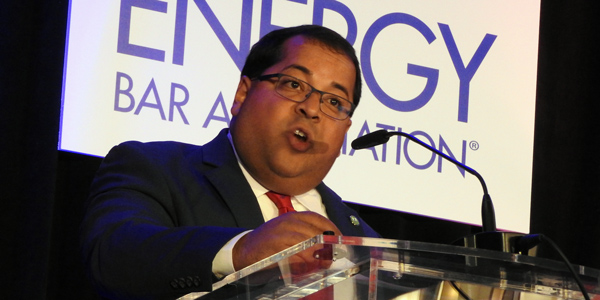By Rory D. Sweeney
WASHINGTON — Neil Chatterjee, FERC’s recently appointed interim chair, already has plans for shaking up the 40-year-old commission.
Speaking Tuesday at the Energy Bar Association’s midyear conference, the former energy adviser to Senate Majority Leader Mitch McConnell (R-Ky.) tallied off six objectives for revising FERC’s regulatory posture.
They ranged from streamlining project review for natural-gas and hydropower projects, to determining a “just and reasonable” return on equity for transmission projects; from changing FERC’s interpretation of de novo review and revising the Public Utility Regulatory Policies Act, to addressing cyber threats. Chatterjee said he also wants to ensure the industry doesn’t outrun itself with technology advancements.
Reliability
But although it was buried deep in his speech, his timeliest goal appears to be maintaining grid reliability “during a time of rapid change,” which comes in light of the Department of Energy’s recent Notice of Proposed Rulemaking calling for price supports for coal and nuclear plants.
Chatterjee has already said he supports investigating the issue. (See FERC Chair Praises Perry’s ‘Bold Leadership’ on NOPR.) On Tuesday, he suggested that those baseload resources may be needed to avoid changing the generation fleet too much, too quickly.
“Reliability is and will continue to be our foremost priority,” he said, listing off several of FERC’s responsibilities related to reliability. “In my view, the DOE NOPR fits comfortably within those efforts. … We must ensure we don’t find ourselves coming to regret not having asked hard questions like these amongst all the changes in the energy industry.”
He also said that news of attempts by Russia and North Korea to hack the grid highlight other reliability needs.
“It’s clear that defending our nation from international cyber threats is one of the most serious challenges of our time,” he said.
Streamlining Review
Chatterjee also voiced support for streamlining the review process for natural gas pipeline and hydropower projects.
“The FERC review process continues to get longer and longer, due in large part to increased participation in the process by stakeholders, including numerous legal challenges,” he said. “FERC owes both sides an opportunity … to receive a timely up-or-down decision.”
Chatterjee dismissed suggestions that FERC depart from its “longstanding” reliance on customer agreements to gauge the economic need for a project “in favor of weighing a broad range of economic, social and aesthetic values.” Gas subscriptions on pipelines are “clear, unequivocal statements of economic need by the market itself.” (See FERC Chair: Court Ruling Won’t Change Pipeline Reviews.)
He blamed project delays on incomplete applications, negotiations with federal and state agencies and the “sheer number” of comments, saying “FERC is most definitely not the principle source of those delays.” He urged applicants to use FERC’s prefiling process and said he hopes to “pursue understandings that can be reached on an agency-to-agency basis” to improve response time. There is no way to speed up comments or responding to them thoughtfully, he said.
Additional Issues
With the generation fleet changing and transmission constraints raising prices, consumers stand to benefit from developing additional transmission infrastructure, Chatterjee said. The “most critical near-term piece” is finding the right financial incentives for enticing project investment, which will involve determining “what represents a just and reasonable return on equity for transmission projects.”
Courts have rejected FERC’s interpretation of its de novo review authority five times, he said, so the commission must develop a “proper scope” that is “fair and legally defensible.” FERC has been chastised by Congress in the past for not properly handling enforcement cases. (See FERC Enforcement Process Under Fire in House Hearing.)
Finally, Chatterjee indicated he plans to address FERC’s implementation of PURPA, specifically the “1-mile rule” for qualifying facilities. FERC has ruled that QFs located within 1 mile of each other are considered to be “located at the same site” and that wind farms of 20 MW or larger within ISO/RTO regions are presumed to have access to competitive markets and thus ineligible for PURPA’s must-purchase obligation on incumbent utilities. However, stakeholders have complained that QF developers are circumventing the 20-MW cap by creating separate corporate entities for individual turbines or small groups of turbines, or disaggregating large projects by siting turbines more than 1 mile apart. (See Witnesses Offer Alternate Realities on Need for PURPA Reform.)




